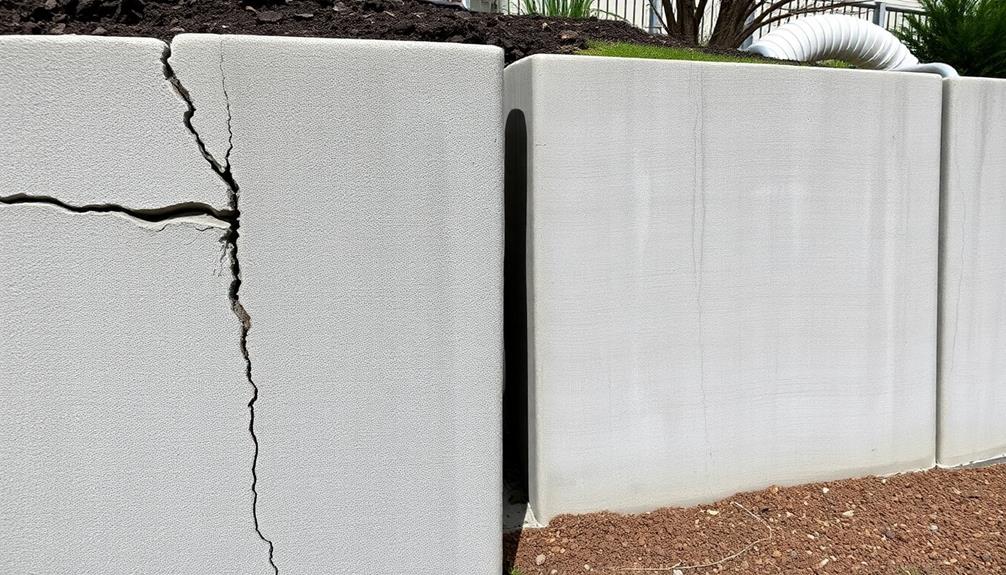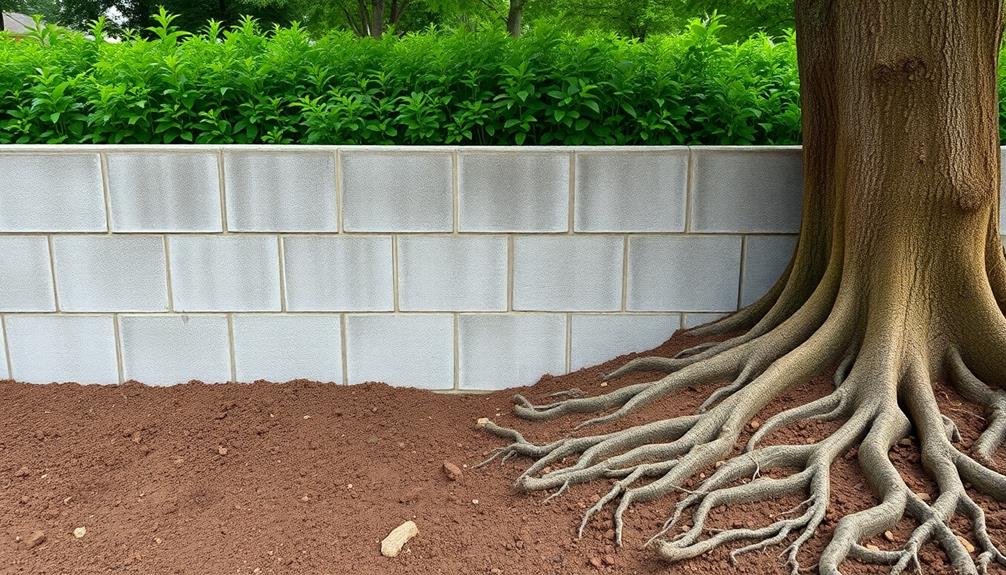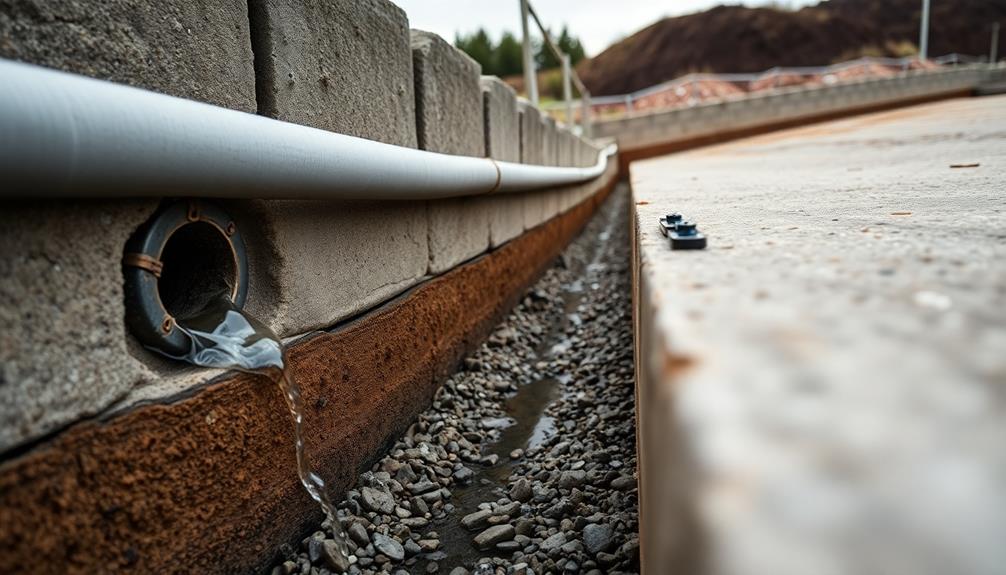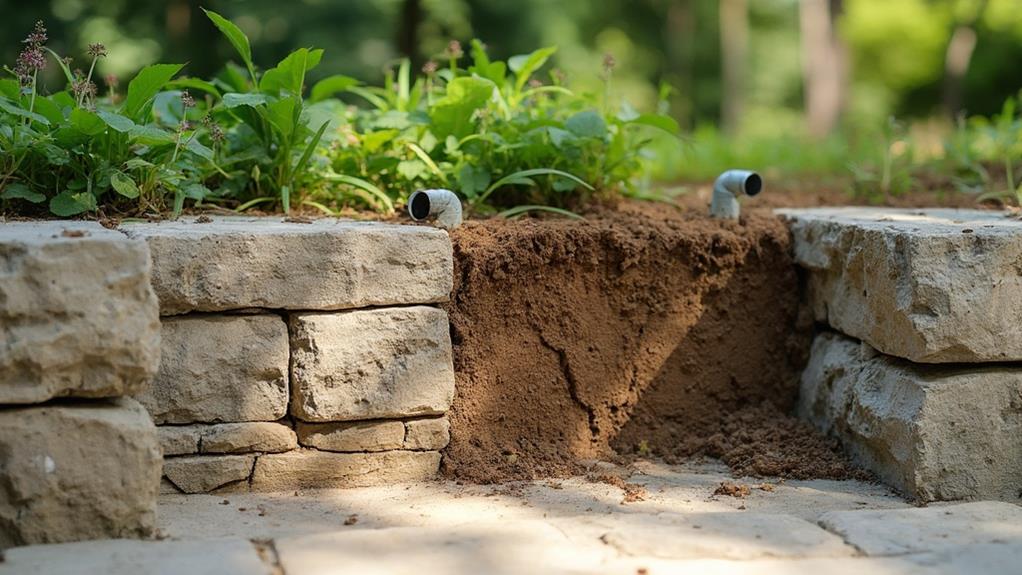Regular maintenance of retaining walls is indispensable for preserving structural integrity and preventing costly failures. Periodic inspections allow for early detection of issues such as material deterioration, soil pressure imbalances, and drainage system blockages. Timely interventions, including repairs to weakened areas, clearing of debris, and reinforcement of drainage systems, can considerably extend a wall's lifespan and maintain its load-bearing capacity. Proper upkeep guarantees the wall continues to withstand lateral forces from retained soil, safeguarding surrounding landscapes and property values. By implementing an all-encompassing maintenance program, property owners can avoid major structural problems and maintain the aesthetic appeal of their retaining walls. Further exploration of maintenance practices reveals additional benefits and cost-saving potential.
Table of Contents
ToggleWalls Contractor Highlights
- Regular maintenance prevents material deterioration, extending the wall's lifespan and structural integrity.
- Timely inspections identify early signs of damage, allowing for prompt repairs before issues escalate.
- Proper drainage management minimizes water accumulation and hydrostatic pressure, reducing the risk of failure.
- Ongoing maintenance preserves the wall's aesthetic appeal, enhancing overall property value and appearance.
- Routine upkeep is a cost-effective solution, avoiding expensive major repairs or complete wall replacement.
Structural Integrity of Retaining Walls

Maintaining the structural integrity of retaining walls requires an encompassing approach that addresses multiple vital factors. A meticulous assessment of the wall's load-bearing capacity is essential to guarantee it can withstand the forces exerted upon it.
Implementing strategies to prevent material deterioration helps extend the wall's lifespan and functionality, which is especially important for boulder retaining walls due to their natural appeal and long-lasting nature. Effective soil pressure management techniques, including proper drainage systems and backfill composition, play a pivotal role in mitigating the risk of structural failure and preserving the wall's stability over time.
Load-Bearing Capacity Assessment
The structural integrity of a retaining wall hinges on its load-bearing capacity, which must be regularly assessed to guarantee continued safety and functionality. As members of a community reliant on these critical structures, it is our collective responsibility to verify their ongoing performance.
Professional engineers conduct thorough evaluations, employing sophisticated techniques such as finite element analysis and geotechnical investigations to determine the wall's current load-bearing capabilities. These assessments involve examining the wall's foundation, analyzing soil conditions, and evaluating potential surcharge loads. Engineers meticulously calculate the lateral earth pressures, hydrostatic forces, and any additional loads that may impact the wall's stability.
Through this process, they can identify areas of concern, such as excessive deflection or potential failure points, and recommend appropriate remedial measures. Regular load-bearing capacity assessments not only safeguard our shared infrastructure but also provide valuable data for future design improvements. By proactively maintaining and monitoring these structures, we collectively contribute to the longevity and reliability of our built environment, ensuring the safety and well-being of our community for generations to come.
Material Deterioration Prevention
Effective material deterioration prevention strategies are crucial for preserving the structural integrity of retaining walls. These structures are constantly exposed to environmental factors that can compromise their strength and longevity. By implementing a comprehensive maintenance plan, property owners can significantly extend the lifespan of their retaining walls and ensure optimal performance.
To effectively prevent material deterioration, consider the following key strategies:
- Regular inspections to identify early signs of wear, such as cracks, spalling, or efflorescence
- Application of protective coatings to shield against moisture intrusion and chemical attack
- Proper drainage management to minimize water accumulation and hydrostatic pressure
Addressing these aspects collectively helps safeguard the wall's structural components from degradation. Timely interventions, such as repairing minor damage and reinforcing vulnerable areas, can prevent more extensive and costly repairs in the future. Additionally, selecting appropriate materials for construction and repair that are suited to local climate conditions can enhance the wall's resilience against environmental stressors. By prioritizing material deterioration prevention, property owners demonstrate their commitment to maintaining safe and reliable infrastructure, ultimately contributing to the overall well-being of their communities.
Soil Pressure Management
Proper management of soil pressure is a vital aspect of maintaining the structural integrity of retaining walls. As soil accumulates behind the wall, it exerts considerable lateral pressure, which can lead to structural instability if not adequately addressed. To guarantee the longevity and safety of retaining walls, property owners must implement a thorough soil pressure management strategy.
This strategy typically involves several key components, including proper drainage systems, regular inspections, and timely interventions. Effective drainage is essential to prevent water buildup behind the wall, which can profoundly increase soil pressure and compromise stability. Installing weep holes, french drains, or other drainage solutions helps mitigate this risk.
Regular inspections allow for the early detection of potential issues, such as bulging, cracking, or soil erosion, which may indicate excessive pressure. When problems are identified, prompt action is imperative. This may involve reinforcing the wall, improving drainage, or redistributing soil to alleviate pressure. By actively managing soil pressure, property owners can significantly extend the lifespan of their retaining walls, ensuring they continue to function effectively and safely for years to come.
Benefits

Regular maintenance of retaining walls offers numerous benefits that extend far beyond mere aesthetics. By implementing a thorough maintenance program, property owners can drastically enhance the structural integrity of their retaining walls, effectively prolonging their lifespan and ensuring ideal performance for years to come.
This maintenance includes inspecting for signs of damage, such as cracks, shifts, or erosion, and performing necessary repairs or reinforcement to maintain stability. Additionally, well-maintained retaining walls not only improve the overall visual appeal of a property but also represent a cost-effective long-term solution, potentially saving substantial amounts on future repairs or replacements.
Increased Structural Integrity
One of the primary benefits of retaining wall maintenance is the significant increase in structural integrity. Regular upkeep safeguards that the wall continues to perform its essential function of soil retention and erosion prevention, safeguarding both property and landscaping. By addressing minor issues before they escalate, homeowners and property managers can avoid costly repairs or complete wall replacement in the future.
Proper maintenance enhances structural integrity through:
- Reinforcement of weakened areas, such as deteriorating mortar joints or cracked blocks
- Removal of accumulated debris and vegetation that can exert pressure on the wall
- Repair of drainage systems to prevent water buildup and soil saturation
Professional inspection and maintenance services can identify potential weak points in the retaining wall's structure, allowing for targeted interventions. These proactive measures not only extend the wall's lifespan but also guarantee its continued effectiveness in withstanding the lateral forces exerted by the retained soil. By investing in regular maintenance, property owners demonstrate a commitment to preserving their landscape's aesthetic appeal and structural soundness, ultimately protecting their investment and maintaining the overall value of their property.
Extended Lifespan
A retaining wall's lifespan can be markedly extended through consistent maintenance practices. By implementing regular inspections and timely repairs, property owners can substantially prolong the functional life of their retaining structures, potentially doubling or even tripling their expected duration. This extended lifespan not only safeguards the continued safety and stability of the surrounding landscape but also represents a substantial return on investment for the initial construction costs.
Proper maintenance routines, including drainage system upkeep, crack sealing, and vegetation management, work synergistically to prevent premature deterioration. These practices mitigate the cumulative effects of environmental stressors, such as water infiltration, freeze-thaw cycles, and root intrusion, which can accelerate structural degradation. Additionally, addressing minor issues promptly prevents them from escalating into major structural failures, thereby avoiding costly replacements.
Improved Aesthetic Appeal
Beyond the structural benefits of maintenance, retaining walls offer significant aesthetic advantages when properly cared for. Regular upkeep guarantees that these architectural elements remain visually appealing, enhancing the overall appearance of your property. Well-maintained retaining walls contribute to a polished, professional landscape that reflects positively on the property owner's attention to detail and commitment to excellence.
To illustrate the aesthetic improvements that result from proper maintenance, consider the following:
- Clean, algae-free surfaces that showcase the natural beauty of the wall materials
- Vibrant, well-tended plantings in tiered garden beds supported by the wall
- Seamless integration of lighting elements that accentuate the wall's contours at night
Cost-Effective Long-Term Solution
From a financial standpoint, prioritizing retaining wall maintenance proves to be a cost-effective long-term solution for property owners. By investing in regular upkeep, homeowners and businesses can considerably extend the lifespan of their retaining walls, thereby avoiding the substantial expenses associated with major repairs or complete replacements. This proactive approach not only safeguards the initial investment but also guarantees the continued functionality and stability of the structure over time.
Regular maintenance allows for the early detection and resolution of minor issues before they escalate into more severe problems. This preventive strategy can include tasks such as addressing small cracks, reinforcing weak points, and updating drainage systems. By consistently implementing these measures, property owners can maintain the structural integrity of their retaining walls, reducing the likelihood of catastrophic failures that could result in extensive property damage and potential liability issues.
Additionally, well-maintained retaining walls contribute to the overall value of the property, potentially increasing its marketability and resale value. This long-term perspective on maintenance aligns with the interests of those seeking to protect their investments and maintain a sense of community pride in their properties.
Drainage System Inspection Considerations

Regular inspection of a retaining wall's drainage system is vital for maintaining its structural integrity and performance. Key considerations include identifying clogged drainage outlets, evaluating water flow patterns, and checking the condition of filter fabric. The following table outlines specific inspection tasks, their frequency, and potential consequences of neglect:
| Inspection Task | Recommended Frequency | Consequences of Neglect |
|---|---|---|
| Clear drainage outlets | Quarterly | Water buildup, increased pressure |
| Observe water flow | After heavy rainfall | Erosion, soil instability |
| Examine filter fabric | Annually | Sediment infiltration, reduced drainage |
| Check for wall cracks | Bi-annually | Structural weakening, failure risk |
Identifying Clogged Drainage Outlets
How can one effectively identify clogged drainage outlets in a retaining wall? Recognizing the signs of obstruction is indispensable for maintaining the wall's structural integrity and preventing potential failures. As conscientious property owners, we must remain vigilant in our inspection routines, paying close attention to the telltale indicators of drainage issues.
To identify clogged drainage outlets, look for:
- Water seepage or staining on the face of the retaining wall, particularly during or after periods of rainfall
- Accumulation of debris, soil, or vegetation around the outlet areas
- Unusual pooling or saturated soil at the base of the wall, indicating improper water diversion
Regular inspection of drainage outlets is vital for preserving the longevity and functionality of retaining walls. By carefully examining these critical components, we can detect potential problems before they escalate into more serious issues. Utilizing specialized equipment, such as inspection cameras or moisture meters, can provide additional insight into the condition of drainage systems. It's important to document findings meticulously and address any identified issues promptly to guarantee the continued stability and performance of the retaining wall structure.
Assessing Water Flow Patterns
During the inspection of a retaining wall's drainage system, analyzing water flow patterns is crucial for identifying potential issues and ensuring ideal performance. Property owners and maintenance professionals should observe how water moves across and around the retaining wall structure during rainfall or when water is deliberately introduced to simulate precipitation. This evaluation helps determine if the drainage system is effectively channeling water away from the wall and its foundation.
Key factors to consider when examining water flow patterns include the slope of the ground adjacent to the wall, the presence of any pooling or standing water, and the efficiency of water movement through designated drainage paths. Inspectors should pay close attention to areas where water may be redirected towards the wall instead of away from it, as this can lead to increased hydrostatic pressure and potential structural damage over time.
Additionally, evaluating the flow patterns can reveal any inconsistencies in the soil composition or compaction that may affect the wall's stability. By thoroughly investigating these water flow patterns, property owners can proactively address drainage issues and maintain the longevity and structural integrity of their retaining walls.
Checking Filter Fabric Condition
An essential component of retaining wall drainage system inspection is checking the condition of the filter fabric. This crucial indispensable element serves to prevent soil particles from infiltrating the drainage system while allowing water to pass through. Over time, filter fabric can degrade, tear, or become clogged, compromising its effectiveness and potentially leading to structural issues within the retaining wall.
To thoroughly assess the filter fabric's condition, property owners and maintenance professionals should:
- Carefully excavate small sections behind the retaining wall to visually inspect the fabric for signs of wear, tears, or discoloration.
- Gently probe the fabric with a blunt tool to test its integrity and resistance to punctures.
- Collect soil samples adjacent to the fabric to analyze for fine particle accumulation, which may indicate fabric failure.
Regular inspection and maintenance of filter fabric are crucial vital for preserving the longevity and stability of retaining walls. By identifying and addressing issues early, property owners can avoid costly repairs and potential structural failures. Implementing a systematic approach to filter fabric assessment ensures that drainage systems continue to function optimally ideally, safeguarding the integrity of the retaining wall and surrounding landscape.
Walls Contractor FAQ
How Often Should I Schedule Professional Inspections for My Retaining Wall?
Professional inspections for your retaining wall should be scheduled annually for most residential structures. However, if you notice any signs of damage or instability, it's vital to have an expert assess the wall immediately to safeguard our community's safety.
Can I Perform Basic Retaining Wall Maintenance Myself?
Yes, you can perform basic retaining wall maintenance yourself. Regular visual inspections, cleaning debris, and addressing minor issues are tasks homeowners can handle. However, for complex problems or structural concerns, it's best to consult a professional for guidance and safety.
What Signs Indicate That My Retaining Wall Needs Immediate Attention?
Key signs your retaining wall needs immediate attention include visible cracks, bulging or leaning, water seepage, soil erosion behind the wall, or separation of wall components. These issues can compromise structural integrity and safety if left unaddressed.
Are There Specific Maintenance Requirements for Different Types of Retaining Walls?
Different retaining wall types have specific maintenance needs. Masonry walls require mortar inspection, while timber walls need rot checks. Concrete walls benefit from crack monitoring, and gabion walls necessitate regular wire basket inspections. Consult a professional for tailored maintenance plans.
How Does Landscaping Near a Retaining Wall Affect Its Maintenance Needs?
Landscaping near retaining walls can greatly impact maintenance needs. Proper plant selection and placement are essential to prevent root damage, soil erosion, and water drainage issues. Regular trimming and monitoring of vegetation help guarantee the wall's stability and longevity.







